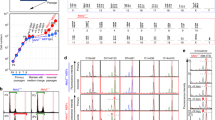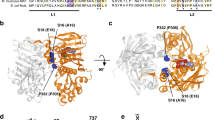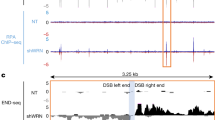Abstract
Mismatch repair has a central role in maintaining genomic stability by repairing DNA replication errors and inhibiting recombination between non-identical (homeologous) sequences1,2. Defects in mismatch repair have been linked to certain human cancers, including hereditary non-polyposis colorectal cancer (HNPCC) and sporadic tumours3,4,5. A crucial requirement for tumour cell proliferation is the maintenance of telomere length6, and most tumours achieve this by reactivating telomerase7. In both yeast and human cells, however, telomerase-independent telomere maintenance can occur as a result of recombination-dependent exchanges between often imperfectly matched telomeric sequences8,9,10,11,12. Here we show that loss of mismatch-repair function promotes cellular proliferation in the absence of telomerase. Defects in mismatch repair, including mutations that correspond to the same amino-acid changes recovered from HNPCC tumours13, enhance telomerase-independent survival in both Saccharomyces cerevisiae and a related budding yeast with a degree of telomere sequence homology that is similar to human telomeres. These results indicate that enhanced telomeric recombination in human cells with mismatch-repair defects may contribute to cell immortalization and hence tumorigenesis.
This is a preview of subscription content, access via your institution
Access options
Subscribe to this journal
Receive 51 print issues and online access
$199.00 per year
only $3.90 per issue
Buy this article
- Purchase on Springer Link
- Instant access to full article PDF
Prices may be subject to local taxes which are calculated during checkout




Similar content being viewed by others
References
Modrich, P. & Lahue, R. S. Mismatch repair in replication fidelity, genetic recombination and cancer biology. Annu. Rev. Biochem. 65, 101– 133 (1996).
Rayssiguier, C., Thaler, D. S. & Radman, M. The barrier to recombination between Escherichia coli and Salmonella typhimurium is disrupted in mismatch-repair mutants. Nature 342, 389– 401 (1989).
Leach, F. S. et al. Mutations of a mutS homolog in hereditary nonpolyposis colorectal cancer. Cell 75, 1215– 1225 (1993).
Fishel, R. et al. The human mutator gene homolog MSH2 and its association with hereditary nonpolyposis colon cancer. Cell 75, 1027– 1038 (1993).
Modrich, P. Mismatch repair, genetic stability and cancer. Science 266, 1959– 1960 (1994).
Hahn, W. C. et al. Inhibition of telomerase limits the growth of human cancer cells. Nature Med. 5, 1164– 1170 (1999).
Shay, J. W. & Bacchetti, S. A survey of telomerase activity in human cancer. Eur. J. Cancer 33, 787– 791 (1997).
Lundblad, V. & Blackburn, E. H. An alternate pathway for yeast telomere maintenance rescues est1- senescence. Cell 73, 347– 360 (1993).
McEachern, M. J. & Blackburn, E. H. Cap-prevented recombination between terminal telomeric repeat arrays (telomere CPR) maintains telomeres in Kluyveromyces lactis lacking telomerase. Genes Dev. 10, 1822– 1834 (1996).
Nakamura, T. M., Cooper, J. P. & Cech, T. R. Two modes of survival of fission yeast without telomerase. Science 282, 493– 496 (1998).
Teng, S. C. & Zakian, V. A. Telomere–telomere recombination is an efficient bypass pathway for telomere maintenance in Saccharomyces cerevisiae. Mol. Cell. Biol. 19, 8083– 8093 (1999).
Dunham, M. A., Neumann, A. A., Fasching, C. L. & Reddel, R. R. Telomere maintenance by recombination in human cells. Nature Genet. 26, 447– 450 (2000).
Studamire, B., Price, G., Sugawara, N., Haber, J. E. & Alani, E. Separation-of-function mutations in Saccharomyces cerevisiae MSH2 that confer mismatch repair defects but do not affect nonhomologous-tail removal during recombination. Mol. Cell. Biol. 19, 7558– 7567 (1999).
Flint, J. et al. Sequence comparisons of human and yeast telomeres identified structurally distinct subtelomeric domains. Human Mol. Genet. 6, 1305– 1313 (1997).
Allshire, R. C., Dempster, M. & Hastie, N. D. Human telomeres contain at least three types of G-rich repeat distributed non-randomly. Nucleic Acids Res. 17, 4611– 4627 (1989).
Lundblad, V. & Szostak, J. W. A mutant with a defect in telomere elongation leads to senescence in yeast. Cell 57, 633– 643 (1989).
Lingner, J. et al. Reverse transcriptase motifs in the catalytic subunit of telomerase. Science 276, 561– 567 (1997).
Fishman-Lobell, J. & Haber, J. E. Removal of nonhomologous DNA ends in double-strand break recombination: the role of the yeast ultraviolet repair gene RAD1. Science 258, 480– 484 (1992).
Nicholson, A., Hendrix, M., Jinks-Robertson, S. & Crouse, G. F. Regulation of mitotic homeologous recombination in yeast. Function of mismatch repair and nucleotide excision repair genes. Genetics 154, 133– 146 (2000).
Tran, H. T., Gordenin, D. A. & Resnick, M. A. The 3′→5′ exonucleases of DNA polymerases delta and epsilon and the 5′→3′ exonuclease Exo1 have major roles in postreplication mutation avoidance in Saccharomyces cerevisiae. Mol. Cell. Biol. 19, 2000– 2007 (1999).
Datta, A. et al. Checkpoint-dependent activation of mutagenic repair in Saccharomyces cerevisiae pol3-01 mutants. Mol. Cell 6, 593– 603 (2000).
Shampay, J., Szostak, J. W. & Blackburn, E. H. DNA sequences of telomeres maintained in yeast. Nature 310, 154– 157 (1984).
McEachern, M. J. & Blackburn, E. H. A conserved sequence motif within the exceptionally diverse telomeric sequences of budding yeasts. Proc. Natl Acad. Sci. USA 91, 3453– 3457 (1994).
Acknowledgements
We thank S. Plon for the initial suggestion to test the effects of a MMR defect in telomerase-defective strains; M. McEachern and E. Alani for the gifts of strains and plasmids; and J. Haber, S. Rosenberg, P. Hastings and S. Evans for critical comments. This work was supported by a US Army Breast Cancer Research Predoctoral Fellowship to A.R. and grants from the NIH and Houston Cancer Fighters to V.L.
Author information
Authors and Affiliations
Corresponding author
Supplementary Information
Methods
Saccharomyces cerevisiae strains. All S. cerevisiae strains were isogenic derivatives of the diploid strain DVL173 (MAT a/a ura3-52/ura3-52 lys2-801/lys2-801 ade2-101/ade2-101 trp1-∆1/trp1-∆1 his3-∆200/his3-∆200 leu2-∆1/leu2-∆1 est2-∆1::URA3/EST2, CF-SUP11-TRP1/CF-SUP11-TRP1). Heterozygous disruptions of MSH2, MSH3, MSH6, MLH1, PMS1, RAD1 or RAD10 (to generate DVL 320, DVL264, DVL265, DVL266, DVL 267, DVL268 or DVL269, respectively) were obtained by transforming DVL173 with KANMX2 fragments1 flanked by 50 bp of homology to the relevant gene, and dissected to obtain appropriate haploid single and double mutant. A heterozygous msh3-∆/MSH3 msh6-∆/MSH6 est2-∆/EST2 diploid strain (DVL280) was obtained by transforming an msh6-∆ haploid with an msh3-∆::hisG-URA3-hisG disruption cassette2 and mating to an est2-∆ haploid. A heterozygous pol3-01/POL3 est2-∆/EST2 diploid strain, DVL333, was obtained by replacing one copy of the POL3 gene with pol3-01 in DVL173 by conventional gene targeting methods; the POL3 genotype of haploid derivatives was scored by increased canavanine resistance and/or sequencing. Missense mutations of MSH23 were introduced into DVL340 (a Trp- derivative of DVL320) on CEN TRP1 plasmids and subsequently dissected, maintaining selection for the plasmid.
-
1.
Wach, A., Brachat, A., Pohlmann, R. & Philippsen, P. New heterologous modules for classical or PCR-based gene disruptions in Saccharomyces cerevisiae. Yeast 10, 1793-1808 (1994).
-
2.
New, L., Liu, K. & Crouse, G.F. The yeast gene MSH3 defines a new class of eukaryotic MutS homologues. Mol. Gen. Genet. 239, 97-108 (1993).
-
3.
Studamire, B., Price, G., Sugawara, N., Haber, J.E. & Alani, E. Separation-of-function mutations in Saccharomyces cerevisiae MSH2 that confer mismatch repair defects but do not affect nonhomologous-tail removal during recombination. Mol. Cell. Biol. 19, 7558-7567 (1999).
-
4.
McEachern, M.J. & Blackburn, E. H. Cap-prevented recombination between terminal telomeric repeat arrays (telomere CPR) maintains telomeres in Kluyveromyces lactis lacking telomerase. Genes Dev. 10, 1822-1834 (1996).

Supplementary figure 1
(GIF 15 KB)
Enhancement of telomerase-independent survival by mlh1-∆, pms1-∆, or msh3-∆ msh6-∆.
a-c, Distribution of growth scores for each mutant strain (number of samples indicated in parenthesis) after ~25, 50, 75, and 100 generations of growth.

Supplementary figure 1
(GIF 15 KB)
d-f, Liquid growth assays for 3 samples of each indicated genotype. P ≤ 0.002, 0.06, 0.006, and 0.001 for days 6-9, respectively, for est2-∆ versus est2-∆ mlh1-∆; P ≤ 0.05, 0.002, and 0.02 for days 5-7, respectively, for est2-∆ versus est2-∆ pms1-∆; P ≤ 0.008, 0.04, and 0.04 for days 5-7, respectively, for est2-∆ versus est2-∆ msh3-∆ msh6-∆
Rights and permissions
About this article
Cite this article
Rizki, A., Lundblad, V. Defects in mismatch repair promote telomerase-independent proliferation. Nature 411, 713–716 (2001). https://doi.org/10.1038/35079641
Received:
Accepted:
Published:
Issue Date:
DOI: https://doi.org/10.1038/35079641
This article is cited by
-
Telomere heterogeneity linked to metabolism and pluripotency state revealed by simultaneous analysis of telomere length and RNA-seq in the same human embryonic stem cell
BMC Biology (2017)
-
Identification of telomere dysfunction in Friedreich ataxia
Molecular Neurodegeneration (2015)
-
Regulation of the hTERT promoter activity by MSH2, the hnRNPs K and D, and GRHL2 in human oral squamous cell carcinoma cells
Oncogene (2009)
-
Msh2 deficiency leads to chromosomal abnormalities, centrosome amplification, and telomere capping defect
Oncogene (2006)
-
Id2 protein is selectively upregulated by UVB in primary, but not in immortalized human keratinocytes and inhibits differentiation
Oncogene (2005)
Comments
By submitting a comment you agree to abide by our Terms and Community Guidelines. If you find something abusive or that does not comply with our terms or guidelines please flag it as inappropriate.



